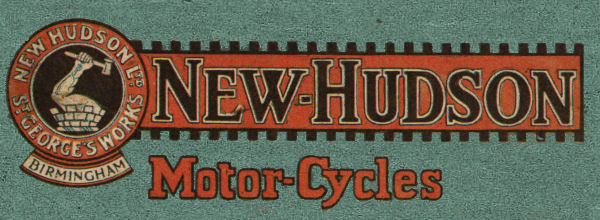


1890 The company was established as Hudson Bicycles
1903 The first motorcycle was produced. It was an early primitive fitted with a De Dion engine. At that time the firm was based in Icknield Street, Birmingham, but they soon left the powered market.
Report from the 1902 Stanley Show
New Hudson Cycle Co, Birmingham. Two very serviceable looking motor-bicycles are to be seen here, one fitted with a vertical 2 h.p. De Dion engine, embodying all the latest improvements, including their special silencer. The motor is clamped to the down tube, and in addition is supported behind from the bracket and seat tube. A special point about this motor is that it gives a much narrower tread than usual.
The other machine shown is fitted with the latest pattern 2 h.p. Minerva engine. Both machines have their special tubular stays to the front forks, spray carburetters, automatic lubrication, and are finished in the usual style for which this enterprising firm are noted. Price of either machine £45.
Motor Cycling, 26th November 1902
1910 Late that year the company returned, this time in Summer Hill Street. They listed two models of conventional design, fitted with 2½hp or 3½hp JAP engines, belt drive, Druid forks and with various transmission options.
The New Hudson Cycle Co., Ltd. Birmingham.
A decided novelty will be shown on this stand in light weight machines with 2 H.P. free engine and 3-speed gear, catalogued at 45 guineas. The makers claim for this machine that it is a light-weight with all the efficiency of the heavy-weight, and that it is capable of going anywhere under any conditions.
The intention is to make this the model de Luxe of light-weights, therefore the very highest quality fitments will be employed - Brooks best saddle, Dunlop non-skid tyres, together with the most luxurious finish and equipment possible. The same machine will also be catalogued without 3-speed gear and free engine at 35 guineas. A third machine will be shown of the New Hudson 3 1/2 H.P., possessing all the same high-class fitments and finish, and retailing at 48 guineas.
1913 The JAP engines were dropped and they added their own 2¾hp motor.
1914 A 6hp V-twin appeared, plus a 211cc two-stroke lightweight. This and the 3½hp single ran on until 1916.
New Hudson Cycle Co., Summer Hill Street, Birmingham.
The Olympia Show report of 1921 describes the light two-stroke model as follows:
1923 The two-strokes were stopped, but 346cc and 296cc models appeared.
1924 A 346cc ohv model appeared.
1926 Models of 490cc and 594cc were listed, with sporting names.
Excerpt from Reports on sports machines of 1926 (published in 1949 by Motor Sport Magazine)
1927 A New Hudson came second in the Senior TT and records were set at Brooklands.
1929 A 249cc sv model, known as the Ixion, was sold at a reduced price in order to clear stocks.
In 1929 the company purchased the Girling brake patent from the inventor Albert Girling, to supply brake systems to Ford, Austin, Rover and Riley
1931 The range was revised so that engines were inclined with partial enclosure.
1932 The Depression years were hard for all concerned. The inclined engines had had their heyday, enclosure was not popular and the new engines had problems.
1933 Having hit a low spot, the company ceased the production of motorcycles and concentrated on making Girling brakes.
1940 The name of New Hudson reappeared on an autocycle powered by a 98cc Villiers engine.
1943 The Girling interests were sold to Lucas and the company went back to bicycles making with a range of autocycles or lightweight motorcycles.
Post-war. The firm had, by then, become part of BSA and the autocycle continued until the end of the decade.
1948 The New Hudson was one of the cheapest autocycles available - priced at £48 17s 11d [£48.90] for that year.
1949 The autocycle was revised to use the Villiers 99cc 2F unit, and continued for several years.
1956 During that year the machine was completely restyled and ran on in that form.
1958 Production came to a close.
In 1930, the Ixion name re-surfaced when New Hudson failed to sell a large batch of 249cc sv models that had been produced to capitalize on public interest. The BSA Round Tank had been so successful that there were, by 1929, too many others on the market, many of which lacked the staying-power of the BSA.
By changing the name to Ixion, New Hudson were able to slash the price of the motorcycles in order to clear stocks.
The company also used the name for engines sold to other firms, both at home and abroad, including Rex of Halmstad
Sources: Graces Guide, The Motor Cycle
If you have further information or a query related to this page, please contact us